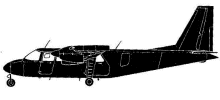Incident Overview

Description
The aircraft was on a short flight of about 12 minutes between airfields on Weddell Island and Beaver Island, Falkland Islands. It was being operated by a single pilot who had considerable experience on both the aircraft type and in operating in the Falkland Islands. This was his first day back after a period of leave, having returned to the Falkland Islands the previous day from a stay overseas. Weddell Island was experiencing a southerly wind at the time the pilot took off so he was expecting to land on runway 13 at Beaver Island. Whilst downwind for runway 13 he contacted his destination by radio to be informed that the wind strength and direction favoured instead an approach to runway 27. The pilot then repositioned the aircraft for runway 27, rolling out of the final turn on short final. Video footage taken by the passengers on board recorded that about 8 seconds after rolling out onto final the stall warning horn sounded, quickly followed by an impact as the aircraft appeared to touch down hard. The pilot reported that he had felt the right wing drop just before the impact. A later inspection revealed marks from the left wheel on a small bank about 14.5 m short of the start of the runway undershoot area and from the right wheel about 12.4 m short. There were further marks from both wheels indicating the aircraft had struck further banks before both wheels remained on the ground 3.5 m inside the undershoot area. During the subsequent landing roll the aircraft veered initially to the right but the pilot managed to keep it under control. He taxied the aircraft clear of the runway before shutting down. On inspecting the aircraft it was apparent there was significant damage to the right landing gear, engine mounts and wing. Conclusions The evidence indicates it is likely the aircraft stalled, or suffered an unexpected descent, on final approach whilst at low height, just short of the undershoot area. This was probably caused by a combination of the low approach speed, necessary to operate to the short strip, and turbulence or windshear caused by the topography of the local area under the prevailing wind conditions. The pilot commented that the stall warner often sounds just prior to touch down and the fact it sounded on this occasion did not necessarily indicate a full stall of the aircraft. Despite the challenges offered by the airstrip, the pilot was experienced and capable of operating under the prevailing conditions. The pilot was confident that despite his recent travel back to the Falkland Islands fatigue was not a contributory factor. The pilot also commented that it is not unusual in this sort of operation to fly only a short final approach, but it is possible that the late repositioning due to the change of landing runway contributed to the handling of the flight, just prior to touchdown. As a result of the accident, the operator conducted its own review. This determined that whilst the strips on Beaver Island complied with relevant requirements, as a further precaution some of the banks short of the undershoot areas would be levelled off.
Primary Cause
Unexpected descent/stall due to low approach speed, combined with turbulence/windshear exacerbated by the local terrain.Unexpected descent/stall due to low approach speed, combined with turbulence/windshear exacerbated by the local terrain.Share on:




